Guofa Cai
Multimodal Radio and Vision Fusion for Robust Localization in Urban V2I Communications
Aug 25, 2025Abstract:Accurate localization is critical for vehicle-to-infrastructure (V2I) communication systems, especially in urban areas where GPS signals are often obstructed by tall buildings, leading to significant positioning errors, necessitating alternative or complementary techniques for reliable and precise positioning in applications like autonomous driving and smart city infrastructure. This paper proposes a multimodal contrastive learning regression based localization framework for V2I scenarios that combines channel state information (CSI) with visual information to achieve improved accuracy and reliability. The approach leverages the complementary strengths of wireless and visual data to overcome the limitations of traditional localization methods, offering a robust solution for V2I applications. Simulation results demonstrate that the proposed CSI and vision fusion model significantly outperforms traditional methods and single modal models, achieving superior localization accuracy and precision in complex urban environments.
M2BeamLLM: Multimodal Sensing-empowered mmWave Beam Prediction with Large Language Models
Jun 17, 2025Abstract:This paper introduces a novel neural network framework called M2BeamLLM for beam prediction in millimeter-wave (mmWave) massive multi-input multi-output (mMIMO) communication systems. M2BeamLLM integrates multi-modal sensor data, including images, radar, LiDAR, and GPS, leveraging the powerful reasoning capabilities of large language models (LLMs) such as GPT-2 for beam prediction. By combining sensing data encoding, multimodal alignment and fusion, and supervised fine-tuning (SFT), M2BeamLLM achieves significantly higher beam prediction accuracy and robustness, demonstrably outperforming traditional deep learning (DL) models in both standard and few-shot scenarios. Furthermore, its prediction performance consistently improves with increased diversity in sensing modalities. Our study provides an efficient and intelligent beam prediction solution for vehicle-to-infrastructure (V2I) mmWave communication systems.
BeamLLM: Vision-Empowered mmWave Beam Prediction with Large Language Models
Mar 13, 2025Abstract:In this paper, we propose BeamLLM, a vision-aided millimeter-wave (mmWave) beam prediction framework leveraging large language models (LLMs) to address the challenges of high training overhead and latency in mmWave communication systems. By combining computer vision (CV) with LLMs' cross-modal reasoning capabilities, the framework extracts user equipment (UE) positional features from RGB images and aligns visual-temporal features with LLMs' semantic space through reprogramming techniques. Evaluated on a realistic vehicle-to-infrastructure (V2I) scenario, the proposed method achieves 61.01% top-1 accuracy and 97.39% top-3 accuracy in standard prediction tasks, significantly outperforming traditional deep learning models. In few-shot prediction scenarios, the performance degradation is limited to 12.56% (top-1) and 5.55% (top-3) from time sample 1 to 10, demonstrating superior prediction capability.
On the Performance of LoRa Empowered Communication for Wireless Body Area Networks
Nov 07, 2023



Abstract:To remotely monitor the physiological status of the human body, long range (LoRa) communication has been considered as an eminently suitable candidate for wireless body area networks (WBANs). Typically, a Rayleigh-lognormal fading channel is encountered by the LoRa links of the WBAN. In this context, we characterize the performance of the LoRa system in WBAN scenarios with an emphasis on the physical (PHY) layer and medium access control (MAC) layer in the face of Rayleigh-lognormal fading channels and the same spreading factor interference. Specifically, closed-form approximate bit error probability (BEP) expressions are derived for the LoRa system. The results show that increasing the SF and reducing the interference efficiently mitigate the shadowing effects. Moreover, in the quest for the most suitable MAC protocol for LoRa based WBANs, three MAC protocols are critically appraised, namely the pure ALOHA, slotted ALOHA, and carrier-sense multiple access. The coverage probability, energy efficiency, throughput, and system delay of the three MAC protocols are analyzed in Rayleigh-lognormal fading channel. Furthermore, the performance of the equal-interval-based and equal-area-based schemes is analyzed to guide the choice of the SF. Our simulation results confirm the accuracy of the mathematical analysis and provide some useful insights for the future design of LoRa based WBANs.
STAR-RIS Aided MISO SWIPT-NOMA System with Energy Buffer: Performance Analysis and Optimization
Aug 18, 2023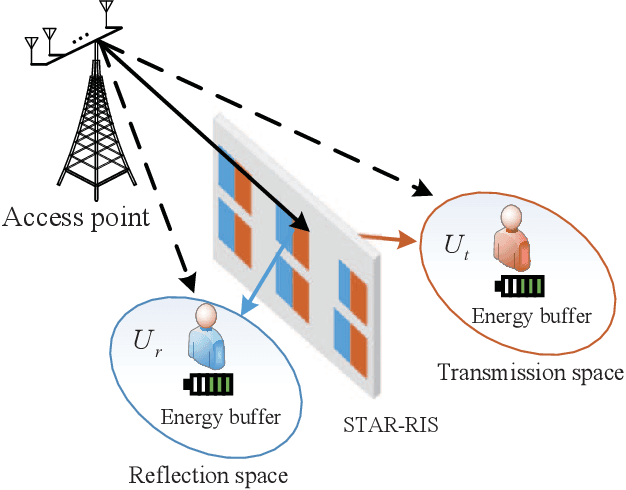
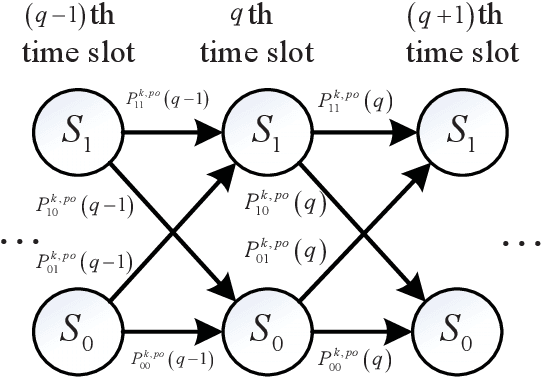
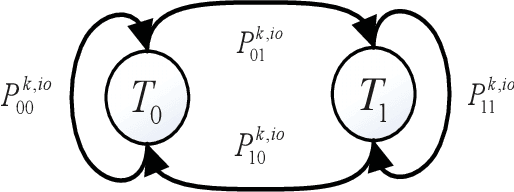
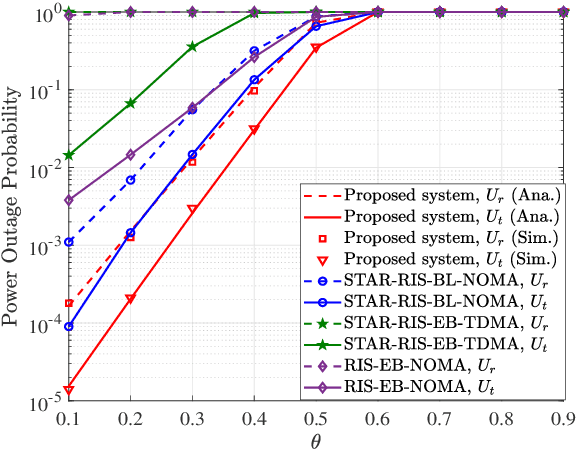
Abstract:In this paper, we propose a simultaneous transmitting and reflecting reconfigurable intelligent surface (STAR-RIS) and energy buffer aided multiple-input single-output (MISO) simultaneous wireless information and power transfer (SWIPT) non-orthogonal multiple access (NOMA) system, which consists of a STAR-RIS, an access point (AP), and reflection users and transmission users with energy buffers. In the proposed system, the multi-antenna AP can transmit information and energy to several single-antenna reflection and transmission users simultaneously in a NOMA fashion, where the power transfer and information transmission states of the users are modeled using Markov chains. The reflection and transmission users harvest and store the energy in energy buffers as additional power supplies. The power outage probability, information outage probability, sum throughput, and joint outage probability closed-form expressions of the proposed system are derived over Nakagami-m fading channels, which are validated via simulations. Results demonstrate that the proposed system achieves better performance in comparison to the STAR-RIS aided MISO SWIPT-NOMA buffer-less, conventional RIS and energy buffer aided MISO SWIPT-NOMA, and STAR-RIS and energy buffer aided MISO SWIPT-time-division multiple access (TDMA) systems. Furthermore, a particle swarm optimization based power allocation (PSO-PA) algorithm is designed to maximize the sum throughput with a constraint on the joint outage probability. Simulation results illustrate that the proposed PSO-PA algorithm can achieve an improved sum throughput performance of the proposed system.
Performance Analysis of a Two-Hop Relaying LoRa System
Aug 02, 2021
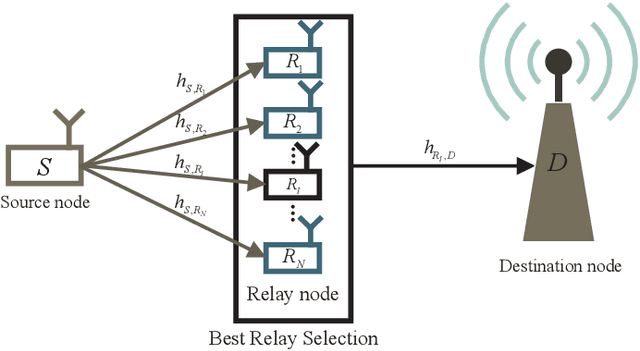
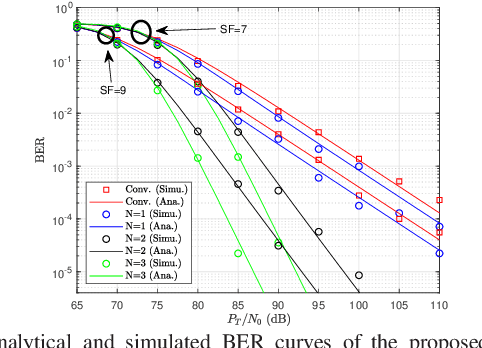
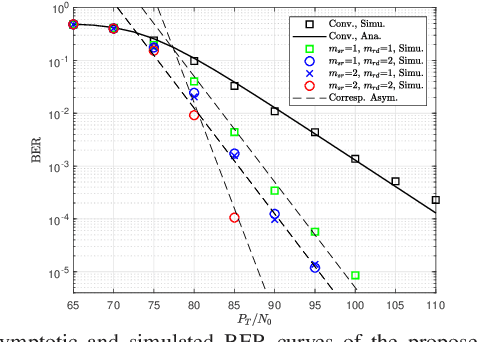
Abstract:The conventional LoRa system is not able to sustain long-range communication over fading channels. To resolve the challenging issue, this paper investigates a two-hop opportunistic amplify-and-forward relaying LoRa system. Based on the best relay-selection protocol, the analytical and asymptotic bit error rate (BER), achievable diversity order, coverage probability, and throughput of the proposed system are derived over the Nakagamim fading channel. Simulative and numerical results show that although the proposed system reduces the throughput compared to the conventional LoRa system, it can significantly improve BER and coverage probability. Hence, the proposed system can be considered as a promising platform for low-power, long-range and highly reliable wireless-communication applications.
A New Frequency-Bin-Index LoRa System for High-Data-Rate Transmission: Design and Performance Analysis
Mar 29, 2021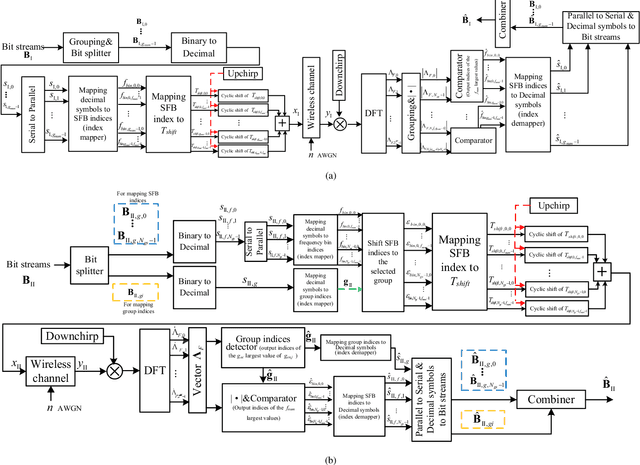
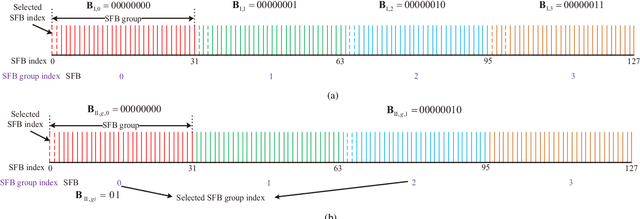
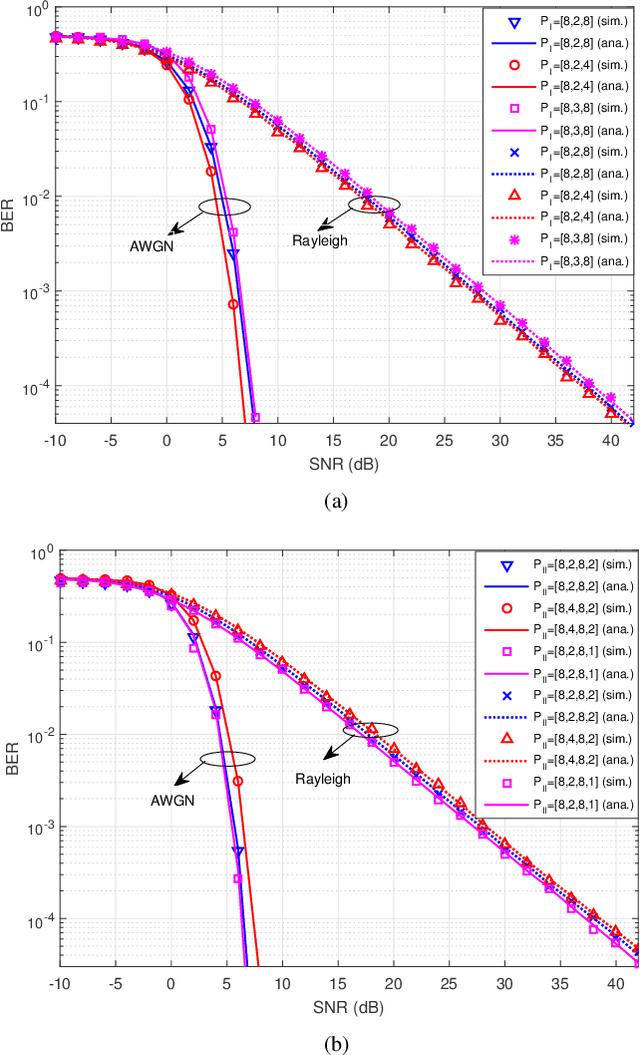
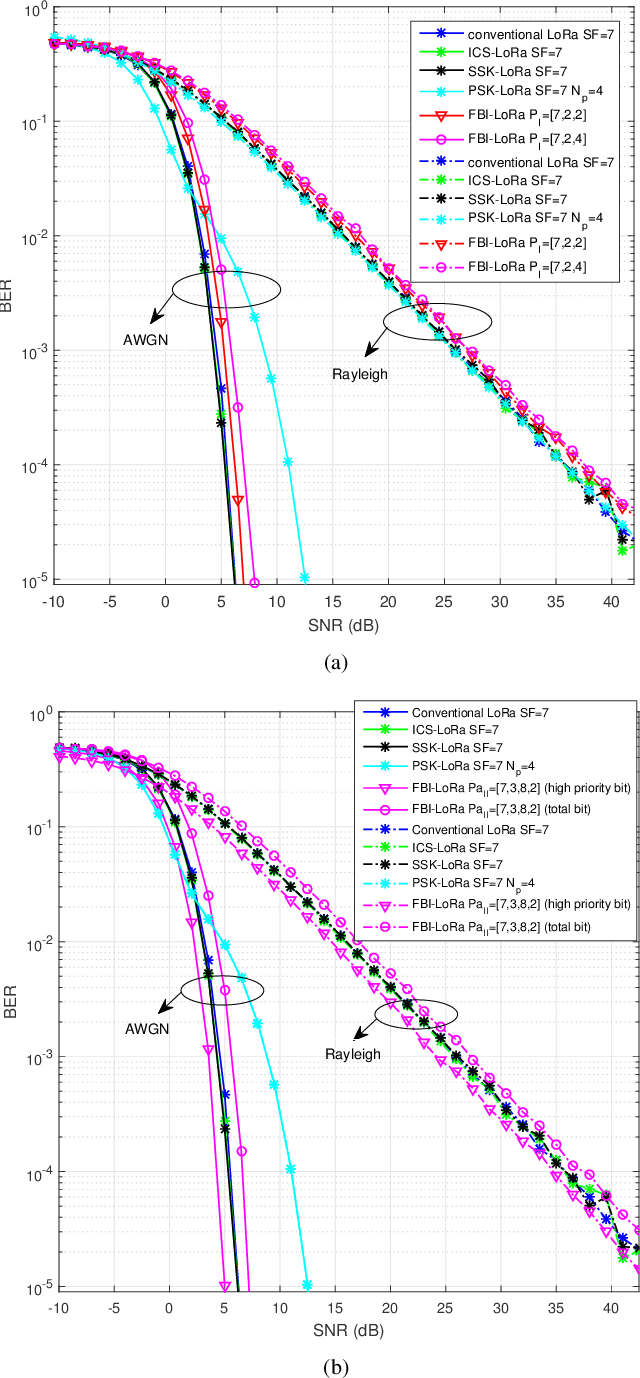
Abstract:As an attempt to tackle the low-data-rate issue of the conventional LoRa systems, we propose two novel frequency-bin-index (FBI) LoRa schemes. In scheme I, the indices of starting frequency bins (SFBs) are utilized to carry the information bits. To facilitate the actual implementation, the SFBs of each LoRa signal are divided into several groups prior to the modulation process in the proposed FBI-LoRa system. To further improve the system flexibility, we formulate a generalized modulation scheme and propose scheme II by treating the SFB groups as an additional type of transmission entity. In scheme II, the combination of SFB indices and that of SFB group indices are both exploited to carry the information bits. We derive the theoretical expressions for bit-error-rate (BER) and throughput of the proposed FBI-LoRa system with two modulation schemes over additive white Gaussian noise (AWGN) and Rayleigh fading channels. Theoretical and simulation results show that the proposed FBI-LoRa schemes can significantly increases the transmission throughput compared with the existing LoRa systems at the expense of a slight loss in BER performance. Thanks to the appealing superiorities, the proposed FBI-LoRa system is a promising alternative for high-data-rate Internet of Things (IoT) applications.
 Add to Chrome
Add to Chrome Add to Firefox
Add to Firefox Add to Edge
Add to Edge